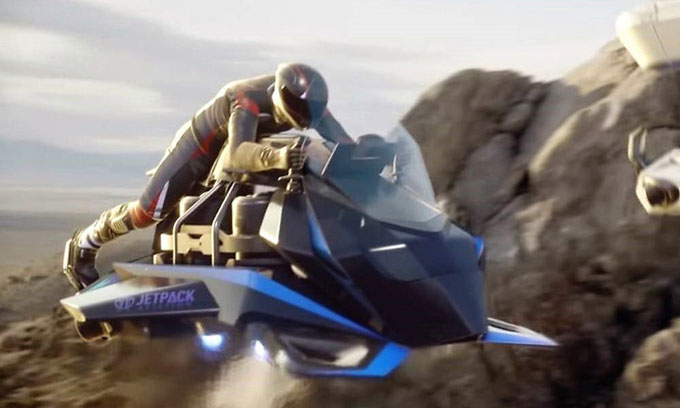The Speeder flying motorcycle uses a jet engine, capable of vertical takeoff and landing, and can fly up to 4,500 meters.
JetPack Aviation, a California-based company, has begun taking pre-orders for the vertical takeoff and landing flying motorcycle Speeder, as reported by Aerospace Testing International on July 18. The Speeder is being developed for various purposes such as personal transportation, military applications, and medical use.

Design of the vertical takeoff and landing flying motorcycle Speeder. (Photo: JetPack Aviation).
JetPack Aviation has completed preliminary testing with the first prototype named P1 in May. During the tests, experts used a tether to ensure safety while P1 was in motion. The tests achieved several objectives, including demonstrating the engine’s operation, the exhaust system’s connection, and the flight control system. Within a 24-meter tether system, P1 demonstrated the ability to take off, ascend, hover, maneuver, and transition to forward flight gradually.
The next prototype of the Speeder, P1.5, is expected to undergo flight testing in the coming months to assist experts in data collection and continue developing the P2 model. The P2 is scheduled for flight testing between January and July of next year.
The P1 prototype undergoing testing with a safety tether. (Video: JetPack Aviation).
The P1.5 has a smaller frame than the P1 and is closer to the final production design. Like the P1, it utilizes four engines, while the production model may be equipped with up to eight engines. The body of the P1.5 also includes components made from carbon fiber. In testing, the prototype will transition from vertical flight to horizontal flight increasingly faster, with improved forward, backward, and lateral flight speeds. The P2 will feature a complete body, equipped with detachable small wings and a nose wing. This vehicle is compact enough to be transported by car.
The Speeder will have a maximum speed of approximately 240 km/h, fly up to 4,500 meters with a flight duration of 30 minutes, and is capable of generating a maximum thrust of over 540 kg. The Speeder is expected to use a jet engine powered by Jet A-1 fuel, kerosene, or diesel. However, under a new agreement with Prometheus Fuels, JetPack Aviation is committed to using 100% carbon-neutral fuel for future operations.



















































